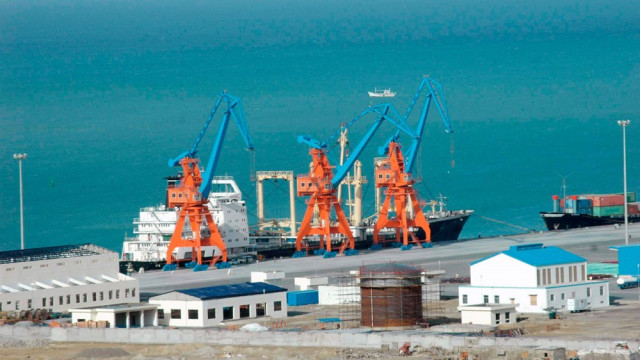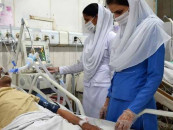Six concerns PML-N government must address about CPEC
To truly benefit, Pakistan should lift the shroud of secrecy that surrounds the multi-billion dollar project

To truly benefit, Pakistan should lift the shroud of secrecy that surrounds the multi-billion dollar project. PHOTO: AFP
Luckily for Pakistan, it is at the start of OBOR with China-Pakistan Economic Corridor (CPEC) being the first of the six corridors part of the project. But to truly benefit from this economic initiative, Pakistan must lift the shroud of secrecy that surrounds the project and address at least the following six concerns to put the sceptics at ease.
Is CPEC a loan, an investment or a grant?
Critics have raised questions about the capital structure of CPEC asking whether it is a loan, a grant or an investment. Governor of State Bank of Pakistan Ashraf Mahmood Wathra, in December 2015, had said: I don't know out of the $46 billion, how much is debt, how much is equity and how much is in kind.
CPEC: another Marshall Plan?
According to information available to public, a part of CPEC’s total cost will be covered through soft or concessionary loans given by Chinese banks on 2% interest rate payable over 20 to 25 years - different from IMF or World Bank loans which are given at rates between 5% and 8.5%. Additionally, Chinese companies are also investing - mostly in Pakistan’s power sector - as part of CPEC. But is it the full picture?
With Pakistan’s external debt already standing at $73 billion, it is necessary to know the exact terms of the agreement to better judge the country’s capability to manage such a massive loan or investment – whatever it is.
How much, if at all, will Pakistan earn in transit fee?
With CPEC, China will save almost $2billion annually in trade expenses as the Kashgar-Gwadar route with its 2,395 kilometres length make the shortest track for transport of goods. Pakistan, on the other hand, can earn a windfall in the form of transit fees - the justification for which is based on the fact that Pakistan will be maintaining and protecting the infrastructure in addition to paying for claims of insurance and damages.
Unequal CPEC distribution: Alliance set to launch protest campaign
However, there are no official details on if and how much will Pakistan charge in transit fee. The only number one gets is from a speculative statement by Minister of Kashmir Affairs and Gilgit-Baltistan Chaudhary Muhammad Barjees Tahir who claimed Pakistan can earn up to $70billion annually in form of transit fee.
Is the environment safe?
For a project spanning from the high mountains in the north to sandy beaches in the south, it is a shame that the government has failed to conduct a proper environmental assessment so far.
While the government has assured that it would work with its Chinese partners to make CPEC environmentally sustainable, experts argue the project will have a far-reaching impact on the environment as trees and glaciers are destroyed in the pursuit of making way for the economic corridor. Another major concern is that most of the CPEC-related power projects are coal-based. Emissions from burning coal for heat and energy cause global warming, making coal the single greatest threat to the climate. Coal mining is also a source of methane, a very potent global warming gas.
Are Chinese businesses favoured over local ones?
The government plans to create 29 industrial parks and 21 mineral zones as part of CPEC - 27 of which will be granted the status of Special Economic Zones (SEZ) – an area with relaxed business and trade laws to boost investment. To attract Chinese businesses to invest in these SEZs, the government has offered them a higher rate of return and tax holidays.
Special security force for CPEC notified: report
While the government hopes SEZs will lift the economy, local businesses fear this will hurt Pakistani industries by making them less competitive. “The inflow of Chinese investment, products and labour will adversely impact the interests of Pakistani business community. The government should either withdraw incentives given to Chinese companies or provide similar incentives to local industries,” the Federation of Pakistan Chambers of Commerce and Industry had said at different occasions.
How is the local population affected and compensated?
The government insists local population along the route of CPEC and related SEZs are the major beneficiary of the bilateral project but many fear they are at the risk of being marginalised and dislocated without due compensation.
For instance, there are reports that fishing communities in Gwadar had to relocate themselves after a fishing ban was imposed in their area as part of security protocol for protection of Chinese workers. Similarly, nationalist elements have expressed concerns that migration of workers from other parts of Pakistan and China will turn local population into a minority.
Is Punjab given priority over other provinces?
Official statistics shared with the parliament last year revealed that out of total 330 CPEC-related projects, 176 are in Punjab while only eight projects allocated for Balochistan. Though a Chinese diplomatic official later tweeted that the project break up is as follows: Balochistan 16, Sindh 13, Punjab 12 and K-P 8, many continue to label CPEC as China Punjab Economic Corridor.
Major questions about CPEC answered
Importance given to the Eastern Route which runs through Punjab, construction of Orange Line with loan from China’s Exim bank and Punjab Chief Minister Shahbaz Sharif accompanying Prime Minister Nawaz Sharif to China on official visits only add fuel to the fire.
There may be a logical explanation for favouring Punjab, if it is true, such as security issues and lack of skilled labour in other places but there are no official data or statements available to ease these concerns.
Manzoor Ali Isran teaches global governance and development at Shaheed Zulfikar Ali Bhutto Institute of Science and Technology where he has been a faculty member since 2008.



















COMMENTS
Comments are moderated and generally will be posted if they are on-topic and not abusive.
For more information, please see our Comments FAQ